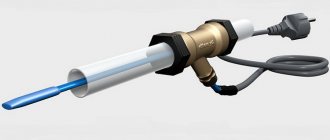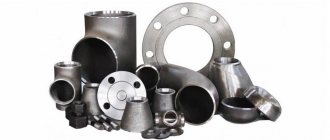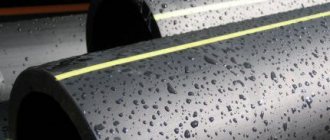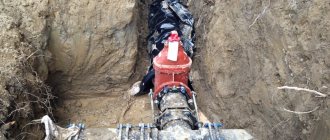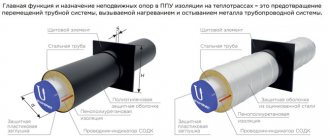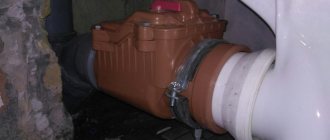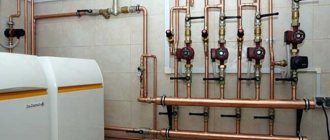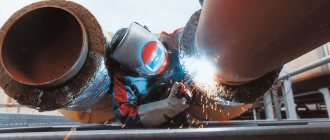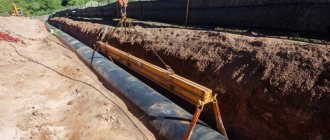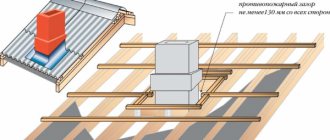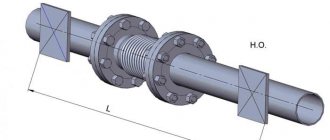Causes of corrosion
Networks of pipelines for life support systems are distributed throughout Russia. With their help, gas, water, petroleum products and oil are efficiently transported. Not long ago, a pipeline was laid to transport ammonia. Most types of pipelines are made of metal, and their main enemy is corrosion, of which there are many types.
The reasons for the formation of rust on metal surfaces are based on the properties of the environment, both external and internal corrosion of pipelines. The risk of corrosion for internal surfaces is based on:
- Interaction with water.
- The presence of alkalis, salts or acids in the water.
Such circumstances may arise on main water supply systems, hot water supply (DHW), steam and heating systems. An equally important factor is the method of laying the pipeline: above ground or underground. The first one is easier to maintain and eliminate the causes of rust formation compared to the second one.
With the pipe-to-pipe installation method, the risk of corrosion is low. When directly installing a pipeline outdoors, rust may form due to interaction with the atmosphere, which also leads to a change in design.
Pipelines located underground, including steam and hot water, are most vulnerable to corrosion. The question arises about the susceptibility to corrosion of pipes located at the bottom of water sources, but only a small part of the pipelines are located in these places.
According to their purpose, pipelines with a risk of corrosion are divided into:
- main lines;
- fishing;
- for heating and life support systems;
- for waste water from industrial enterprises.
Susceptibility to corrosion of main pipeline networks
Corrosion of pipelines of this type is the most well studied, and their protection from external factors is determined by standard requirements. Regulatory documents discuss methods of protection, and not the reasons for the formation of rust.
It is equally important to take into account that in this case only external corrosion is considered, to which the outer section of the pipeline is susceptible, since inert gases pass inside the pipeline. In this case, contact of the metal with the atmosphere is not so dangerous.
For protection against corrosion, according to GOST, several sections of the pipeline are considered: increased and high danger, as well as corrosion-hazardous.
Exposure to negative factors from the atmosphere for high-risk areas or types of corrosion:
- Stray currents arise from direct current sources.
- Exposure to microorganisms.
- The created stress provokes cracking of the metal.
- Waste storage.
- Salty soils.
- The temperature of the transported substance is above 300 °C.
- Carbon dioxide corrosion of an oil pipeline.
An installer for protecting underground pipelines from corrosion must know the design of the pipeline and the requirements of SNiP.
Electrochemical protection
Electrochemical protection refers to active methods of protection against external corrosion, which involve the creation of such an electric current in which the entire metal of the pipeline, despite the heterogeneity of its inclusions, becomes the cathode, and the anode is the metal additionally placed in the ground. There are two types of active protection of pipelines from external corrosion - sacrificial and cathodic .
Protective protection of pipelines
The fight against metal corrosion is relevant in the oil and gas industry (due to corrosion destruction of the bottoms of oil sludge tanks and field pipelines) and other areas of production activity with a high probability of man-made disasters. Tread protection of a pipeline against corrosion is based on stopping the corrosion of metals under the influence of direct electric current. Protective protection is applied simultaneously with protective paint and varnish coatings. This combination allows you to increase their service life and ensures uniform distribution of current over the surface of structures, which compensates for coating defects that arise during operation.
Cathodic protection of pipelines
Cathodic protection is a method of protecting structures by forced cathodic polarization using an external direct current source. The negative pole of the external current source is connected to the protected structure, which acts as a cathode. To form a current-closed circuit, the positive pole of the source is connected to an auxiliary electrode - the anode, which is located in the same environment (soil, water) as the protected object. Thus, cathodic protection consists in the fact that the protected object is negatively polarized and its potential shifts to a value at which the metal corrosion process is significantly or completely suppressed. Cathodic protection is an auxiliary type of protection, therefore cathodic protection is used in conjunction with insulating coatings applied to the outer surface of the protected structure. Otherwise, cathodic polarization of a bare pipeline to the minimum protective potential would require significant protective currents.
Electrochemical protection of pipelines
LLC "GKNT" implements an integrated approach when performing work on electrochemical protection of pipelines:
- Monitoring the corrosion state of underground metal structures and structures
- Installation and operation of installations for electrochemical protection
- Carrying out construction and installation work to organize electrochemical protection
- Carrying out commissioning works for electrochemical protection
- Inspection of electrochemical protection systems and issuance of a technical report
- Carrying out electrical measuring work in our own licensed laboratory
- Supply of equipment, instruments and materials for performing maintenance work on electrochemical protection installations
Installation of racks of control and measuring points
Control and measuring points are designed to indicate the location of underground pipeline routes and monitor their electrochemical protection. They are located on industrial sites of gas distribution stations, on linear parts of underground pipelines, at oil and gas production facilities, in underground oil and petroleum product storage facilities, in underground gas storage facilities, and other industrial facilities with underground metal structures. The control and measuring point consists of a rack and a terminal mounted on the rack. The stand, at the request of the customer, is made of polyvinyl chloride (PVC), metal or fiberglass. The materials used in the installation of racks of control and measuring points are specifically designed for their operation in all climatic zones in the open air. The stand is equipped with an anchor device that prevents the control and measuring point from being freely removed from the ground. The kit additionally includes a kilometer sign, which allows you to visually monitor the location of the pipeline route from the air.
Installation of cathode potential measurement and control systems
LLC "GKNT" installs systems for measuring and regulating cathode potential for the protection of underground structures. All main pipelines, underground wells and storage facilities are equipped with devices for cathodic corrosion protection. Electrochemical protection of pipelines is carried out, as a rule, from cathodic protection stations; sacrificial anodes are used only in the absence of a current source. Cathodic protection systems must regulate the cathodic potential by connecting the negative pole of a direct current source to the protected surface, while the positive pole is connected to specially installed anodes.
Installation of deep anode grounding conductors, creation of anode fields
Deep grounding electrodes are designed for operation in places of limited land allocation for the anode field, as well as for installation in places with low electrical conductivity of the surface soil layer and in geologically complex areas. Deep anode grounding electrodes are designed to protect above-ground and underground oil product tanks, main oil and gas pipelines, underground steel structures, wells, grounding of power lines and other metal structures that are in contact with soil and water. Anodic grounding electrodes are made on the basis of iron-silide alloys; they are resistant to anodic dissolution when working in aggressive alkaline or acidic soils, in fresh and brackish waters and are intended for use in any soil.
Installation of pipeline cathodic protection stations
LLC "GKNT" carries out installation of cathodic protection stations, which are very important in the operation of stationary oil and gas field structures, oil and gas pipelines, and pipelines on the continental shelf. Cathodic protection of underground structures is widespread. Most main pipelines, underground storage facilities and wells are equipped with cathodic protection devices in combination with protective paint coatings.
Electrochemical protection of pipelines at crossings over water barriers, roads and railways
Electrochemical corrosion protection is a set of measures to reduce the electrical potential of pipes and soil. The creation of electrochemical protection of pipelines is regulated by the requirements of SNiP 2.05.06-85. At pipeline crossings under railways and highways, the sections of pipelines that are adjacent to them must have casings and a reinforced type of protective coating. Electrochemical protection of casings at crossings over water barriers and under roads and railways must be done simultaneously with the protection of the main pipeline itself. When commissioning a main pipeline and during its operation, electrical contact between the pipeline and the casing should be regularly monitored and, if detected, it should be eliminated.
Electrochemical corrosion from soil
Due to the difference in voltages formed in individual sections of pipelines, an electron flow occurs. The process of rust formation occurs according to the electrochemical principle. Based on this effect, part of the metal in the anodic zones cracks and flows into the base of the soil. After interaction with the electrolyte, corrosion forms.
One of the significant criteria for ensuring protection against negative manifestations is the length of the line. Along the way you come across soils with different compositions and characteristics. All this contributes to the emergence of a voltage difference between parts of the laid pipelines. The mains have good conductivity, so the formation of galvanic couples with a fairly large extent occurs.
An increase in the rate of pipeline corrosion is provoked by a high electron flux density. The depth of the lines is no less important, since it retains a significant percentage of humidity and the temperature is not allowed to fall below the “0” mark. Mill scale also remains on the surface of the pipes after processing, and this affects the appearance of rust.
Through research, a direct relationship has been established between the depth and area of rust formed on the metal. This is based on the fact that metal with a larger surface area is most vulnerable to external negative manifestations. Special cases include the occurrence of significantly smaller amounts of destruction on steel structures under the influence of the electrochemical process.
The aggressiveness of soils to metal is, first of all, determined by their own structural component, humidity, resistance, alkali saturation, air permeability and other factors. The installer for the protection of underground pipelines from corrosion must be familiar with the pipeline construction project.
The evolution of the development of cathodic protection as a method of protection against corrosion
Cathodic protection is used for tanks, offshore piles, offshore oil installations, sea and river vessels, sluice gates, etc. The era began in 1902 when K. Cohen, and then in 1908 H. Geppert built the first cathode stations to protect pipelines, however, Robert J. Kuhn, who built in 1928, is called the “father” of cathodic protection the first installation of cathodic protection on a main pipeline in New Orleans. R. Kuhn is twice famous: he derived the minimum protective potential - 0.85 V, which is the reference value for electrochemical protection. At this voltage, corrosion processes slow down as much as possible.
Domestic science in the field of electrochemical corrosion protection is famous for such names as: Contribution to the theory of corrosion - G. Akimov, A. Frumkin, N. Tomashov, I. Rosenfeld, Y. Kolotyrkin, Yu. Mikhailovsky, V. Krasnoyarsky, E. Gutman; Pioneers in the practice of cathodic protection - V. Pritula, V. Negreev, A. Spirin, V. Kalman, I. Ershov, M. Trifel, I. Frantsevich, D. Averbukh, V. Vysotsky; The creators of the norms and rules for the practice of electrochemical protection are I. Strizhevsky, V. Levin, M. Suris, A. Marchenko, K. Nikolsky, E. Nikitenko, V. Glazkov, N. Glazov, V. Kotik; The developers of methods for calculating electrochemical protection are B. Lortkipanidze, Y. Iossel, V. Ostapenko, V. Ivanov, V. Lukovich, V. Dmitriev, V. Tkachenko, L. Razumov, O. Tozoni.
For the first time, the use of ECP against corrosion in our country is associated with the commissioning of the Saratov-Moscow main gas pipeline. July 11, 1946 - the gas pipeline went into operation, its length was 843 km. Today, the total length of main gas pipelines is 172.1 thousand km, and with the implementation of the gasification program for Russian regions, this figure increases to 250 thousand km. increases the relevance of combating corrosion with the help of active protection, the main element of which is the cathodic protection station.
In the domestic practice of cathodic protection, from 1947 to the present day, cathodic protection transformer stations based on the use of direct current have been used. During this period of time, the main direction of their modernization was to increase the efficiency of the station and the use of automation systems for the cathodic protection process.
As the practice of using cathodic protection has shown, the polarization process is not a constant value and is discrete in nature. Consequently, the use of stations based on the use of direct current does not make it possible to take into account transient processes of increase and decrease in polarization, which, with a significant increase in current, causes an acceleration of the process of hydrogen evolution on the surface of the protected object. The presence of this process leads to cracking and peeling of the passive protection, as well as to the effect of the introduction of hydrogen atoms into the crystalline structure of the metal, which in turn leads to the intensification of the corrosion process. The search for a solution to this problem led to the emergence of stations operating in pulse mode; an algorithm was developed for stabilizing the protective potential with two-channel regulation: the amplitude and duration of output pulses. Based on theoretical and experimental research, at the beginning of the 21st century, new cathodic protection stations - pulsed ones (IPKZ) - appeared. The devices have high energy efficiency and the ability to quickly respond to changes in the polarization value of the protected object, which in turn allows you to completely avoid the disadvantages inherent in transformer stations, the operation of which is based on the use of direct current.
Currently, LLC Oil and Gas Equipment Plant ANOD, which is one of the structural divisions of PSS Corporation, offers the entire range of pulse cathodic protection converters, the advantage of which is:
- small overall dimensions and weight;
- high efficiency (up to 95%);
- wide range of supply voltages (160 - 260 V);
- ability to operate under low-resistance loads, up to a short circuit;
- slight output voltage ripple.
All modern pulse cathodic protection converters (IPCC) are equipped with automation systems. The use of automation systems in electrochemical protection allows obtaining a number of advantages: increasing the reliability of the structure and its service life; increasing the safety of protective coatings, as well as increasing the service life of anodic groundings. Since the dissolution of the anodes is determined by the total amount of electricity flowing from the anode grounding, its reduction, both by optimizing the mode and by short-term shutdowns used in pulsed mode installations, leads to a decrease in anode wear. Savings in electricity and anodes in these installations reach 50%. In addition, IPKZ can be equipped with telemetry and telemechanics. The functionality implemented by the automatic ECP control system includes:
- remote monitoring and control of operating parameters of cathodic protection stations;
- alarm signaling about station parameters and potential going beyond acceptable limits, as well as about unauthorized access to equipment;
- archiving the main operating parameters of the station;
- logging all system events and user requests;
- formation of a database with automatic recovery of information in cases of interruptions in the operation of the complex;
- provision of data in a standard format for further processing and analysis;
- formation of information display in graphic, text and tabular format.
Corrosion under the influence of stray currents
Rust can arise from an alternating and constant flow of electrons:
- Rust formation under the influence of constant current. Stray currents are currents found in the soil and in structural elements located underground. Their origin is anthropogenic. They arise as a result of the operation of technical devices of direct current, spreading from buildings or structures. They can be welding inverters, cathode protection systems and other devices. The current tends to follow the path of least resistance, as a result, with existing pipelines in the ground, it will be much easier for the current to pass through the metal. The anode is the section of the pipeline from which the stray current exits to the soil surface. The part of the pipeline into which the current enters acts as a cathode. On the described anodic surfaces, currents have an increased density, so it is in these places that significant corrosion spots form. The corrosion rate is not limited and can be up to 20 mm per year.
- Rust formation under the influence of alternating current. When located near power lines with network voltages above 110 kV, as well as in parallel arrangement of pipelines, corrosion occurs under the influence of alternating currents, including corrosion under the insulation of pipelines.
Stress Corrosion Cracking
If a metal surface is simultaneously exposed to external negative factors and high voltage from power lines, which creates tensile forces, then rust formation occurs. According to the research carried out, the new hydrogen-corrosion theory gained its place.
Small cracks are formed when the pipe is saturated with hydrogen, which then ensures an increase in pressure from the inside to levels higher than the required equivalent of the bond of atoms and crystals.
Under the influence of proton diffusion, hydrogenation of the surface layer occurs under the influence of hydrolysis at increased levels of cathodic protection and simultaneous exposure to inorganic compounds.
After the crack opens, the rusting process of the metal accelerates, which is provided by the ground electrolyte. As a result, under the influence of mechanical influences, the metal undergoes slow destruction.
Corrosion due to microorganisms
Microbiological corrosion is the process of rust formation on a pipeline under the influence of living microorganisms. These can be algae, fungi, bacteria, including protozoa. It has been established that the proliferation of bacteria most significantly influences this process. To maintain the vital activity of microorganisms, it is necessary to create conditions, namely nitrogen, humidity, water and salts. Also the conditions are:
- Temperature and humidity indicators.
- Pressure.
- Availability of lighting.
- Oxygen.
Organisms that produce acidic conditions can also cause corrosion. Under their influence, cavities appear on the surface, which are black in color and have an unpleasant odor of hydrogen sulfide. Sulfate-containing bacteria are present in virtually all soils, but the rate of corrosion increases as their numbers increase.
What is electrochemical protection
Electrochemical protection of pipelines against corrosion is a set of measures aimed at preventing the development of corrosion under the influence of an electric field. Specialized rectifiers are used to convert direct current.
Protection against corrosion is carried out by creating an electromagnetic field, as a result of which a negative potential is acquired or the area acts as a cathode. That is, a section of steel pipelines, protected from rust formation, acquires a negative charge, and the grounding becomes positive.
Cathodic protection of pipelines against corrosion is accompanied by electrolytic protection with sufficient conductivity of the medium. This function is performed by soil when laying metal underground highways. Contacting of the electrodes is carried out through conductive elements.
The indicator for determining corrosion indicators is a high-voltage voltmeter or corrosion gauge. Using this device, the indicator between the electrolyte and the soil is monitored, specifically for this case.
Features of cathodic protection of pipes
Corrosion in pipelines usually occurs due to various defects and damage to the pipes - ruptures, cracking, cracks, and so on. Due to corrosion, the sealing of pipes is compromised, which can lead to complete or partial failure of the pipeline. This problem is especially acute for underground pipelines. When pipes are placed underground, areas with different electrical potentials are created. This is due to the heterogeneity of the soil and the presence of various debris of inorganic origin in the soil. If there is a serious potential difference, negatively charged ions in the ground begin to react with the metal. This leads to corrosion, which quickly destroys the pipeline.
Electric potential
Cathodic protection of pipelines against corrosion is carried out according to two standard schemes. Using cathodic polarization and by creating external stations. Pipeline protection should be aimed primarily at reducing the rate of destruction of the pipe material. This is done by reducing the electrical potential of the pipe in comparison with the electrical potential of the soil:
- The electrical potential of most modern pipes is approximately 0.8-0.9 volts.
- It has been experimentally shown that the main rocks of the soil have a potential of approximately 0.5-0.6 volts.
To equalize the electrical potentials, it is necessary to reduce the potential of the pipes by only 0.3-0.4 volts. This allows you to almost completely stop the appearance of rust. If the work is carried out correctly, the rate of natural rusting will be less than 1 mm per year.
Choosing a method
The technology for creating external protection stations is suitable for pipes. In this case, overhead power lines with voltages from 500 to 10,000 volts are used as power sources. The higher the voltage, the more pipes can be serviced. Sometimes there are no such lines in a particular area. In this case, it makes sense to install various generators.
External station technology has one major drawback. To create protection, labor-intensive and complex work will have to be carried out. This significantly increases the cost of creating a pipeline. When working with high voltage, excess electrical voltage may be created at the point of electricity supply - this can cause hydrogen cracking of pipes, so when carrying out installation work, electrical wiring must be done carefully.
Instead of the technology of protective stations, you can use the technique of using galvanic anodes to create a polarization effect. This technology is suitable for soils with low resistivity (up to 50 Ohms per 1 sq. m). If the soil resistivity is very high, then the technology of using galvanic anodes is practically useless due to its low efficiency.
How is electrochemical protection classified?
Corrosion and protection of main pipelines and tanks from it are controlled in two ways:
- A current source is connected to the metal surface. This area acquires a negative charge, that is, it acts as a cathode. Anodes are inert electrodes that have nothing to do with design. This method is considered the most common, and electrochemical corrosion does not occur. This technique is aimed at preventing the following types of corrosion: pitting, due to the presence of stray currents, crystalline type of stainless steel, as well as cracking of brass elements.
- Galvanic method. Protection of main pipelines or sacrificial protection is carried out by metal plates with high levels of negative charges, made of aluminum, zinc, magnesium or their alloys. Anodes are two elements, so-called inhibitors, while the slow destruction of the protector helps maintain the cathode current in the product. Protective protection is used extremely rarely. ECP is performed on the insulating coating of pipelines.
Basic cathodic protection technologies
Cathodic protection is a special method of electrochemical protection of metal objects from rust and corrosion. The main principle is that a negative electrical potential is applied to the metal object being protected. This minimizes metal contact with external ions and substances with an electrical charge. The technology was developed approximately 200 years ago by British scientist Humphry Davy. To confirm his theory, he compiled several reports that were submitted to the government. Based on these reports, the world's first cathodic protection of a large industrial ship was carried out.
Anti-corrosion protection applies to various objects - pipelines, cars, roads, airplanes and so on. Please note that the type of metal does not matter - it can be iron, copper, silver, gold, aluminum, titanium and any other metal, as well as various alloys (with or without alloying additives). Corrosion protection of a car, individual pipe fragments, various decorative items of complex shape, and so on can be equally successful.
1 way
Connecting the part to an external source of electric current (usually compact substations perform this role). When the technology is used, the metal object acts as a cathode, and the electrical substation acts as an anode. Due to this, a shift in the electrical potential occurs, which makes it possible to protect the metal object from electrically active particles. The main areas of application of this technology are the protection of pipelines, welded structures, various platforms, road surface elements, and so on. This technology is quite simple and universal, so it is very popular in the world. Its main disadvantage is the need to connect the protective circuit to an external current source, which can be inconvenient in the case of objects that are located far from human civilization (this problem is partly solved through the use of autonomous energy sources).
Method 2
Galvanic polarization method (galvanic anode technology). This technique is also quite simple and intuitive: a metal object is attached to another that has a negative charge (most often this element is made of light metals - aluminum, zinc, magnesium). Galvanic polarization technology is usually used in cases where there is a protective layer on the surface of the object. This technology is popular in America, where there are a large number of sparsely populated areas and where there is a shortage of external energy sources. Experts argue that galvanic polarization could become very popular in Russia due to the peculiarities of our geography if a protective coating were applied to domestic pipelines (in such a scenario, the use of the first technology would be very difficult, forcing people to look for an alternative).
About the features of electrochemical protection
The main cause of pipeline destruction is the result of corrosion of metal surfaces. After the formation of rust, cracks, ruptures, and cavities form, which gradually increase in size and contribute to the rupture of the pipeline. This phenomenon occurs more often near highways laid underground or in contact with groundwater.
The principle of cathodic protection is the creation of a voltage difference and the action of the two methods described above. After carrying out measuring operations directly at the location of the pipeline, it was found that the required potential to help slow down the destruction process should be 0.85V, and for underground elements this value is 0.55V.
To slow down the corrosion rate, the cathode voltage should be reduced by 0.3V. In this situation, the corrosion rate will not exceed 10 microns/year, and this will significantly extend the service life of technical devices.
One of the significant problems is the presence of stray currents in the soil. Such currents arise from the grounding of buildings, structures, rail tracks and other devices. Moreover, it is impossible to make an accurate assessment of where they may appear.
To create a destructive effect, it is enough to charge steel pipelines with a positive potential in relation to the electrolytic environment, these include pipelines laid in the ground.
In order to provide the circuit with current, it is necessary to supply an external voltage, the parameters of which will be sufficient to break through the resistance of the soil foundation.
As a rule, such sources are power lines with power ratings from 6 to 10 kW. If electric current cannot be supplied, then diesel or gas generators can be used. The installer for the protection of underground pipelines from corrosion must be familiar with the design solutions before performing work.
Electrochemical protection of the main pipeline (design, cathodic, drainage)
Basic principle of cathodic protection.
Cathodic protection (Fig. 1) - protection of an underground metal pipeline when an electric field is applied from an external current source that creates cathodic polarization on the pipeline. In this case, anodic grounding made of metallic or non-metallic electrically conductive materials is subject to corrosion destruction. Such protection is carried out by creating a protective potential difference between the pipeline and its surroundings. ground from a direct (or rectified) current source. The potential difference is created by a cathodic protection station (CPS).
Rice. 1. Schematic diagram of cathodic protection of the main pipeline:
1
— pipeline;
2 -
anode grounding (anode);
3 - connecting power line of direct or rectified current; 4 -
protective grounding;
5 -
source of direct or rectified current;
6 -
cathode terminal;
7,8 -
connection points for the cathode output and drainage, respectively;
I
3 - cathodic protection current
As follows from the cathodic protection scheme, the electric current spreading from the anodic grounding (2) into the soil spreads through it and enters the protected object (1) - the pipeline, polarizing it cathodically. The current entering the protected object is collected at the drainage point (8) and returns to its source (5). The maximum current in the cathodic protection circuit is at the point of connection of the VCS power supply (at the drainage point).
A device including an RMS, anode grounding and connecting wires is called a cathode installation with an external current source. There are two types of VSCs: network powered, powered by existing or specially constructed power lines, and with local current sources, which are used as motor-generators, electric motors of various types, thermogenerators, etc. VSCs consist of a step-down transformer, a current rectifier, voltage regulation devices and control devices. -measuring instruments.
The operating principle of cathodic protection is similar to the electrolysis process. Under the influence of the applied electric field of the source, the movement of half-free valence electrons begins in the direction of anode grounding - current source - protected structure. Losing electrons, the anodic grounding metal atoms pass in the form of ion atoms into the electrolyte solution, i.e. the anodic grounding is destroyed. Ion atoms undergo hydration and are removed deeper into the solution. At the protected structure, due to the operation of the direct current source, an excess of free electrons is observed, i.e. conditions are created for the occurrence of oxygen and hydrogen depolarization reactions characteristic of the cathode.
When implementing electrochemical protection of a pipeline section, the wall of which is damaged by corrosion by more than 10% of its thickness, the minimum protective potential should be 0.05 V more negative.
The minimum protective potential must be maintained at the boundary of the cathodic protection station (CPS) coverage area. Since the value of the protective potential decreases with distance from the SCP connection point (drainage point), the maximum protective potential occurs at the drainage point. To prevent deterioration and peeling of the insulating coating due to the release of hydrogen gas, the maximum value of the protective potential is limited. So, for a steel structure with bitumen or polymer insulation, this value is -1.15 V according to ITU. When a structure does not have a protective coating, the maximum value of the protective potential is not regulated.
In cathodic protection installations, concentrated, distributed, deep and extended anodic groundings are used. To reduce the rate of their dissolution, anodic grounding electrodes are installed in coke breeze. The service life of anode grounding must be at least 15 years.
The basic principle of tread protection.
Protective protection (Fig. 1) against electrochemical corrosion of sections of main pipelines is used at a significant distance from power sources, where the use of cathodic protection is not economically feasible, as well as in places where pipeline sections are incompletely protected by cathodic installations. Protective installations, consisting of a protector, an activator, a conductor and a control column, are used to protect the cones of pipeline transitions through railways and highways, condensate and water collectors, etc. They are connected to the protected structure of a metal protector (anode electrode), which has a lower electrochemical potential compared to the potential of the metal being protected in a given corrosive environment.
Figure 1. Schematic diagram of the tread installation.
1- pipeline; 2 – drainage point;
3 - insulated connecting wire;
4 – protector; A – anode; K – cathode
Tread protection of pipelines is based on the principle of operation of galvanic pairs. When protecting underground metal objects using protector installations, a protector (anode electrode) having a lower electrochemical potential than the potential of the pipe metal is connected to the pipeline. Conditions are created under which the pipeline acts as a cathode and the protector as an anode, as a result of which the corrosive destruction of the pipeline is stopped due to the intensive destruction of the protector.
When installing protective protection, a metal protector (4) is connected to the steel pipeline. As a result of this, a “pipe-protector” galvanic element is formed, in which the pipeline is the CATHODE, the protector is the ANODE, and the soil is the electrolyte.
Destruction is always at the ANODE!!!!!!!!!!!!!!!
Since the protector material is more electronegative, under the influence of the potential difference, a directed movement of electrons occurs from the protector to the pipeline along the conductor 3.
At the same time, the ion atoms of the protector material go into solution, which leads to its destruction.
In this case, the current strength is controlled using a control column .
Thus, metal destruction still occurs. But not the pipeline, but the protector.
Theoretically, to protect steel structures from corrosion, all metals located in the electrochemical voltage series to the left of iron can be used, since they are more electronegative. In practice, protectors are made only from materials that meet the following requirements:
— the potential difference between the tread material and iron (steel) should be as large as possible;
— the current obtained by electrochemical dissolution of a unit mass of the protector (current output) must be maximum;
— the ratio of the tread mass used to create protective current to the total loss of tread mass (utilization factor) should be the greatest.
These requirements are best met by magnesium, zinc and aluminum.
It can be seen that it is difficult to give preference to any one metal. Therefore, protectors are made from alloys of these metals with additives that improve the performance of the tread protection. Depending on the predominant component, alloys can be magnesium, aluminum, or zinc. Manganese (helps to increase current efficiency), indium (prevents the formation of a dense oxide film on the surface of the alloy, and therefore its passivation), etc. are used as additives.
Protection is used with protectors, located both individually (if the condition of the pipeline insulation coating is good) and in groups (used to protect sections of pipelines with poor insulation or uninsulated cartridges at crossings through highways and railways). In addition, protection against corrosion of pipelines can be performed with extended protectors. It is recommended to use protection by single and group collectors in soils with a resistivity of no more than 50 Ohm-m, and in extended soils - no more than 500 Ohm-m.
Increasing the efficiency of the tread unit is achieved by immersing it in a special mixture of salts, called “filler” or activator. Direct immersion of the tread into the soil is less effective than into the aggregate. The aggregate is prepared by mixing dry salts and clay.
The purpose of the placeholders is as follows:
— reduction of self-corrosion
— decrease in anodic polarizability
— reduction of resistance to current spreading from the protector
— elimination of the reasons contributing to the formation of dense layers of corrosion products on the surface of the protectors.
Basic principle of electrical drainage protection.
To electrically protect main pipelines from stray currents, electrical drainage protection is used (Fig. 1), which drains stray currents from the pipeline into the rail part of the electric traction circuit or onto the busbar of the suction cables of the railway traction substation. Stray currents reach significant values and can cause through corrosion of the pipeline walls 3 - 5 years after its installation. In this regard, the commissioning of electric drainage stations must coincide with the laying of the pipeline in the trench and its backfilling.
Figure 1. Schematic diagram of electrical drainage protection of the main pipeline
1 – pipeline; 2 – cathode terminal contact; 3 - cathode terminal; 4 – drainage point on the pipeline; 5 – polarized electric drainage installation; 6 – contact of the circuit with the rail network; 7 – rail network; 8 – drainage cable.
A drainage device (5) is connected to the pipeline (1) at the drainage point (4) using a drainage cable (8), which is also connected to the rail network (7) of the electrified transport. A positive potential difference is created in the “pipeline-rail” circuit and current Idr will flow. Drainage protection operates continuously on stable anode sections, and periodically on alternating sections (when positive potentials appear on the pipeline).
Direct, polarized and reinforced drainage are used.
1) Direct electric drain
is a drainage device with bilateral conductivity.
Drainage in which the current can flow in any direction, that is, from the rails to the pipeline and vice versa. The direct electrical drainage circuit (Fig. 2, a)
includes: rheostat R, switch K, fuse Pr and signal relay SR. The current strength in the pipeline-rail circuit is regulated by a rheostat. If the current value exceeds the permissible value, the fuse will burn out and current will flow through the relay winding, which, when turned on, turns on a sound or light signal.
Direct electrical drainage is used in cases where the potential of the pipeline is constantly higher than the potential of the rail network, where stray currents are discharged. Otherwise, the drainage will turn into a channel for stray currents to flow into the pipeline.
2) Polarized electric drain -
This is a drainage device with one-way conductivity (from the pipeline to the rail) (Fig. 2,
b).
Polarized drainage provides a constant, more negative potential of the protected pipeline. Polarized drainage differs from direct drainage by the presence of a one-way conductivity element - a valve element (VE). With polarized drainage, current flows only from the pipeline to the rail, which eliminates the flow of stray currents onto the pipeline through the drainage wire.
3) Enhanced drainage
(Fig. 2,
c)
are used in cases where it is necessary not only to remove stray currents from the pipeline, but also to ensure the required value of the protective potential on it. Enhanced drainage is a conventional cathode station, connected with the negative pole to the protected structure and the positive pole not to the anode grounding, but to the rails of electrified transport. Due to this connection scheme, firstly, polarized drainage is ensured (thanks to the operation of valve elements in the SCP circuit), and secondly, the cathode station maintains the necessary protective potential of the pipeline. After the pipeline is put into operation, the operating parameters of its corrosion protection system are adjusted. If necessary, additional cathodic and drainage protection stations, as well as protector installations, can be put into operation.
Rice. 2. Schematic diagrams of electrical drains:
R—rheostat; K - switch; Pr - fuse; SR - signal relay; VE - valve element; A - measuring ammeter; Tr—transformer; P - connecting wire
68. Excavation work during the construction of main pipelines in various conditions (swamps, mountain conditions, dune desert conditions, permafrost)
Features of construction of MT in the mountains.
The highly rugged terrain makes it necessary to carry out work on steep ascents and descents, and on sloping areas. Often there are slopes of such steepness that the operation of machines on them is impossible. Such methods of work are required in which the need for their use is eliminated.
As a rule, steep slopes are composed of rocky soils, often highly fractured and saturated with water. Therefore, to the complexities of the terrain are added the difficulties caused by the need to construct shelves for the passage of construction columns and trenches for the pipeline using drilling and blasting operations. The possibility of sudden landslides of huge masses of soil or the occurrence of mudflows poses a danger to construction and installation work.
Landslides often occur as a result of disruption of the natural equilibrium state of slopes during the construction of shelves. Mudflows occur as a result of rainfall, sometimes not even in the area of work, but closer to the tops of the mountains. The flow of mud, stones and water moves at a fairly high speed along the beds of dry streams and rivers and sweeps away everything in its path, forming so-called alluvial cones.
Mountain roads, as a rule, have a large number of steep climbs and turns. This creates significant difficulties in transporting long cargo (pipe sections). In some cases, delivery of even two-pipe sections turns out to be difficult and the construction of pipelines has to be carried out from single pipes.
Difficulties also arise when organizing construction sites. While under normal conditions it is possible to arrange sections along the length of the entire pipeline, in the mountains this often causes great difficulties. The lack of roads, the complexity of the terrain and soil conditions in many cases dictate their requirements. Work can be carried out only in one column, first arranging shelves, a road, a trench. Only after the excavation column can the insulating and laying column proceed.
In very complex areas, work is usually carried out by a complex column, performing all operations at once, right up to backfilling the laid pipeline.
Among the main measures to combat landslides are the following: interception of surface and groundwater, installation of bored reinforced concrete piles that cut through the landslide and enter 2-3 m into the bedrock. In some cases (for small landslides), the installation of retaining walls can give good results.
Features of construction of MT in swamps.
When constructing pipelines in swamps, all currently existing design schemes for laying pipelines are used.
Underground scheme.
The pipeline is laid in the ground to a depth exceeding the diameter of the pipes.
Semi-underground and above-ground schemes.
The pipeline is laid in the ground to a depth less than the diameter, and the protruding part of the pipes is covered with soil.
With a ground-based scheme
— the pipeline is laid on the surface of graded soil.
Overhead scheme.
The pipeline is laid above the ground surface on supports. At pipeline crossings through swamps, one pipeline line is usually laid. However, in swamps of types II and III, with a swamp width of more than 500 m, laying a reserve line is allowed.
The possibility of using one or another scheme in specific conditions is determined by the type of swamp, its natural state, as well as changes in the physical and mechanical properties of the soil under the influence of the pipeline. It must be borne in mind that construction technology can have a significant positive or negative impact on the interaction of pipes and the surrounding soil.
Unlike pipelines laid in dense soils, pipelines laid in swamps using underground or above-ground schemes change their original position over time. This is explained by the extremely strong compressibility of marshy (peaty) soils under the influence of even minor compaction loads. Since longitudinal forces arise in the pipeline during operation, they cause more significant transverse movements of the pipes.
Features of construction of MT in deserts.
The specificity of the construction of main pipelines in the desert lies primarily in the fact that the route passes through deserted, waterless and roadless areas with loose sandy soils or rocky soils covered with a thick layer of dust. Construction in areas of well-developed irrigated land is associated with other difficulties. Irrigated lands are usually crossed by a dense network of irrigation canals, ditches and ditches, which necessitates the construction of a large number of crossings. In addition, driveways and bridges should be built across canals and ditches.
Climatic conditions in desert areas are unusually difficult. Suffice it to say that in summer the temperature reaches 45 - 50 ° C in the shade with a relative air humidity of 6 - 10%, and in winter - 35 ° C. Sands, for example, in the Kyzylkum and Karakum deserts warm up to 70 ° C. Particularly great interference is created by almost continuous hot dry winds and sandstorms. In such conditions, one of the most important tasks is organizing the work and life of builders. Residential towns should be located in the most favorable places where there are sources of water, or at specially arranged strongholds. Typically, the maximum distance of the work front from the town should not exceed 15 - 20 km.
In deserts, it is advisable to carry out linear work using a dismembered-specialized method, that is, dividing a set of works into separate operations entrusted to specialized departments. However, despite the dismemberment, construction is carried out in one stream (defects are unacceptable). Neither excavation, nor welding, nor insulation-laying columns should be separated from each other by a distance greater than 2-3 km, as happens under normal conditions.
When winds blow, a lot of dust and sand settle on the surface of the pipe, which reduces the adhesion of bitumen mastic. To remove dust, a rim with a set of soft brushes is installed in front of the insulation machine, which removes dust.
Features of construction of MT on permafrost soils.
Currently, three main design schemes are used: underground, above-ground and above-ground
. The applicability of each of them in certain specific conditions is determined, first of all, by the thermal interaction of the pipes with their environment. If the temperature of the transported product is negative, then the frozen soil around the pipe will not thaw, and, therefore, its load-bearing capacity will be sufficient for normal operation of the pipeline for any design scheme. If the temperature of the product is positive, then the soil around the pipe thaws. Its load-bearing capacity is sharply reduced, which will lead to pipe subsidence and other undesirable consequences. To predict possible consequences in the operation of pipes during soil thawing, it is necessary to know methods that allow one to calculate the thermal interaction of soil with a pipe.
The difficulty of constructing and operating pipelines in permafrost conditions lies in the fact that the soil under the pipe thaws in certain areas, the pipe sags, and additional bending stresses arise in it.
There are two ways to protect permafrost from thawing:
— pumping products at subzero temperatures (-2 - -3°С), using their cooling in air cooling units (ACO) and in a refrigerator;
— thermal insulation of pipes: a) use of a sand cushion under the pipe (1 m thick); b) production of screens from polyurethane foam.
69. Selection and planning of a site for the construction of an oil depot or gas storage facility
1. The territory allocated for NB must have gaps between the boundaries of the site and neighboring structures in accordance with SNiP 2-106-79.
2. The leeward side from populated areas and structures, so that vapors do not apply to residential buildings, objects with open fire, etc.
Draw a wind rose.
River NBs should be located downstream of the river from the nearest settlements, industrial enterprises, piers, bridges, etc.
- Convenient connection to transport routes.
- At the site itself or close to it, it is necessary to have a source of water supply and energy saving for economic, industrial and fire safety needs.
- Ensuring convenient drainage of storm and sewer water without causing harm to the environment.
- Site d.b. composed of bedrock capable of withstanding a specific load >=0.1 MPa.
Cathodic protection
To reduce the percentage of rust on the surface of pipes, electrode protection stations are used:
- Anode, made in the form of grounding conductors.
- Converters of constant electron flows.
- Equipment for process control and monitoring of this process.
- Cable and wire connections.
Cathodic protection stations are quite effective; when directly connected to a power line or generator, they provide an inhibitory effect of currents. This ensures protection of several sections of the pipeline simultaneously. Parameters can be adjusted manually or automatically. In the first case, transformer windings are used, and in the second, thyristors are used.
The most common in Russia is the high-tech installation - Minevra -3000. Its power is sufficient to protect 30,000 m of highways.
Advantages of the technical device:
- high power characteristics;
- updating the operating mode after overloads in a quarter of a minute;
- using digital regulation, operating parameters are monitored;
- tightness of highly critical connections;
- connecting the device to remote process control.
ASKG-TM are also used, although their power is low, their equipment with a telemetry complex or remote control allows them to be no less popular.
A diagram of the insulation main of the water supply or gas pipeline must be available at the work site.
Video: cathodic protection against corrosion - what is it and how is it performed?
Features of cathodic protection of cars
Corrosion on cars often appears suddenly. The speed of its spread is very high, since the car has a large number of moving parts. During operation, various small cracks and dents may form in such elements. This significantly increases the risk of corrosion. Cathodic protection of a car against corrosion is usually carried out by redistributing the electrical potential.
Usually special electronic modules are used, which are compact in size and mounted inside the car. Installation of such blocks takes no more than 20 minutes.
Additional processing
It is also worth noting that the cathodic protection method is usually combined with other techniques:
- All main parts of the car are coated with special paints and mastics. They create a protective layer on the metal surface. This layer is electrically neutral. Therefore, upon contact with electrically active substances or ions, rusting does not occur.
- Some vehicle components may be coated with protective cathode plates, which also minimize the risk of rust. Plates are usually used to cover the moving parts that are most likely to crack and become damaged. This is the bottom of the car, rear wheel arches, headlights, interior door surfaces, and so on.
